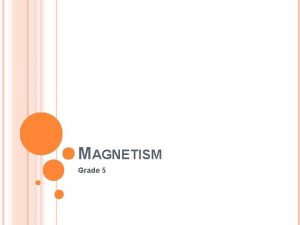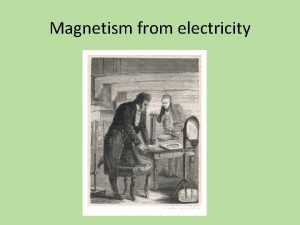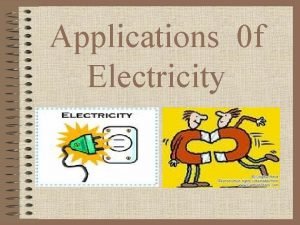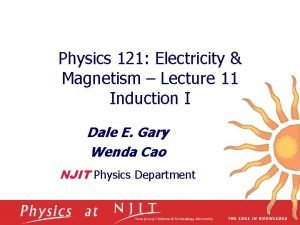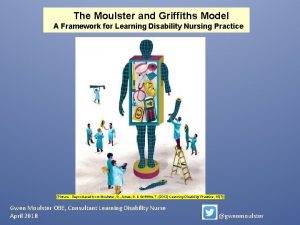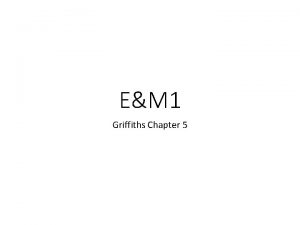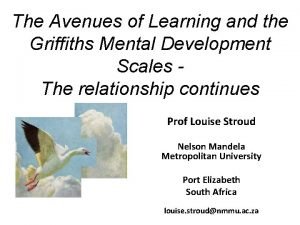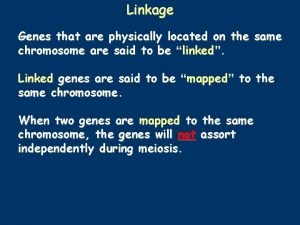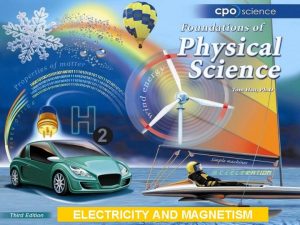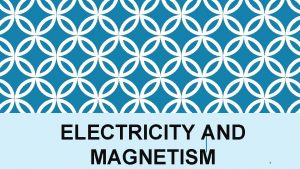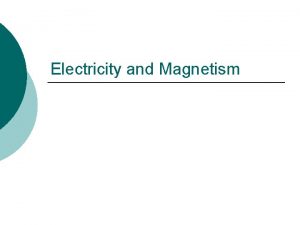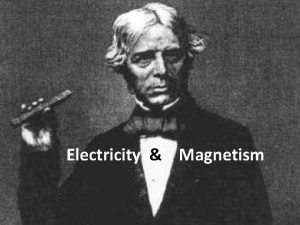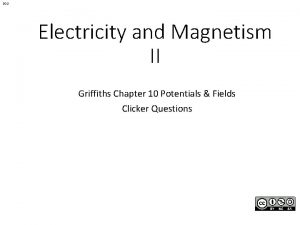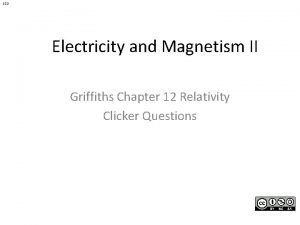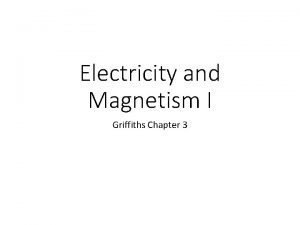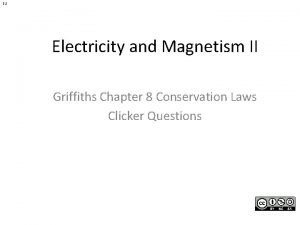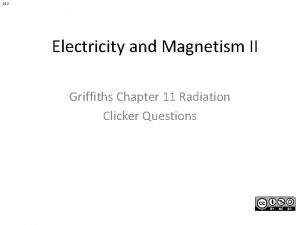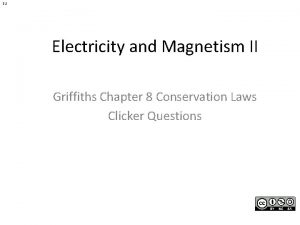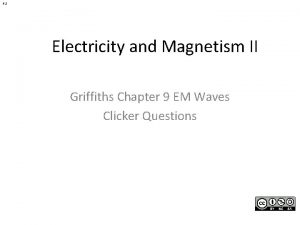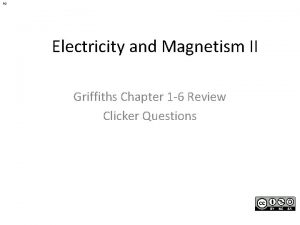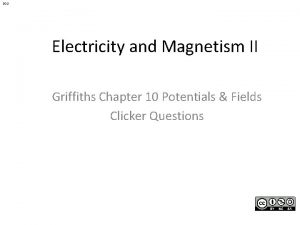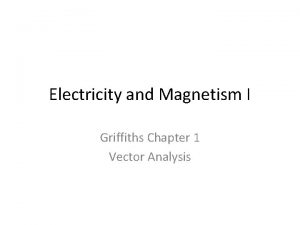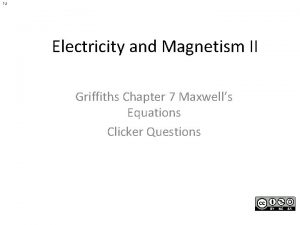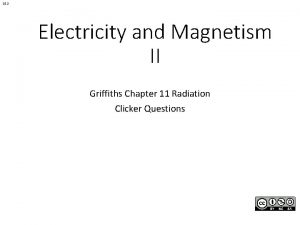12 1 Electricity and Magnetism II Griffiths Chapter





















- Slides: 21

12. 1 Electricity and Magnetism II Griffiths Chapter 12 Relativity Clicker Questions

12. 3 A rocket is moving to the right at speed v = (3/4)c, relative to Earth. On the front of the rocket is a headlight which emits a flash of light beam v = (3/4) c v = 3/4 c v=0 In the reference frame of a passenger on the rocket, the speed of the light flash is A) c B) 7/4 c C) 1/4 c D) None of these According to a person at rest on the earth, the speed of the light flash is A) c B) 7/4 c C) 1/4 c D) None of these According to a person moving toward the rocket at speed (3/4)c, relative to earth, the speed of the light flash is A) c B) 7/4 c C) 1/4 c D) None of these

12. 4 A light bulb flashes in the center of a train car that is moving at speed v with respect to the ground. In the frame of reference of the train car, light wave from the flash strikes the front and back of the train simultaneously. In the frame of reference of the ground, the light strikes the back of the train ______ (fill in the blank) the light strikes the front of the train. A) before B) after C) at the same time as Events that are simultaneous in one frame are not simultaneous in other frames. There is no such a thing as “now”. The time “now” in the Andromeda galaxy, depends on whether we are in the Earth rest frame or the Andromeda rest frame, or…

12. 5 Light clock v Rest frame of clock Δt 0 Moving frame Δt In which frame of reference is the time between tics of the clock longer? A) Rest frame of clock B) moving frame C) no difference “Moving clocks run slower”:

12. 7 I flash a lightbulb (event 1). The light reaches a mirror, and returns to me (event 2) I measure the time Δt =t 2 -t 1 for the complete trip of the light. A long train was passing (speed v) during this experiment. In the reference frame of the train, what is the interval Δt’ between those two events? (As usual, ) D) I’m sure it’s either B or C, but I’m NOT sure which one! E) I’m pretty sure it’s “none of the above”

12. 10 Can one change the order of events in time by measuring them in a different inertial reference frame? A. Always B. Sometimes C. Never

12. 11 The interval between two particular events is positive: Could these events be causally connected? That is, could one of these events have caused the other? A) Yes B) No C) Answer depends on the frame of reference

12. 12 A clock flies over a town at high speed (constant velocity). In the rest frame of the town, the clock reads 0 when it is over the church steeple and it reads 2 when it is over the Old Watch Tower. So according the townsfolk, the flying clock face advanced 2 units between these two events. Do observers in all other references frames agree that the flying clock face advanced 2 units between these two events? A) Yes B) No

12. 16 Displacement is a defined quantity: Is displacement a 4 -vector? A) B) C) D) Yes No Ummm… don’t know how to tell None of these. Be ready to explain your answer.

12. 19 4 -velocity? Imagine this quantity: Is this quantity a 4 -vector? A) Yes, and I can say why. B) No, and I can say why. C) None of the above.

12. 20 4 -velocity? Imagine this quantity: Is this quantity a 4 -vector? A) Yes, and I can say why. B) No, and I can say why. C) None of the above. This object does not Lorentz Transform. NOT a a 4 -vector.

12. 21 4 -velocity? Imagine this quantity: Is this quantity a 4 -vector? A) Yes, and I can say why. B) No, and I can say why. C) None of the above. Proper time

12. 25 The 4 -velocity ημ is defined as What is the invariant length squared of the 4 -velocity, ημ ημ ? A. B. C. D. E. c 2 -c 2 + u 2 c 2 – u 2 None of the above

12. 28 The rest mass m of an object is the mass measured in the rest frame of the object. Is A) Yes. B) No a 4 -vector ? C) Sometimes

12. 27 For isolated systems, the total 4 -momentum is CONSERVED (this is an experimental fact). Is 4 -momentum invariant ? A) Yes, and I can say why. B) No, and I can say why. C) None of the above.

12. 31 Are energy and rest mass Lorentz invariants? A. B. C. D. Both energy and mass are invariants Only energy is an invariant Only rest mass is an invariant Neither energy or mass are invariants

12. 30 A row of positive charges is stationary on the ground. A person with a gauss-meter is running to the right along the row of charges, at the same height as the charges and in front of them. What is the direction of the B-field which the observer measures? A) Right B) left C) up D) down E) B = 0

12. 35 Switch from frame S to frame S-bar: S +s S v -s Frame S (at rest) +s -s v Frame S How does Ex compare to Ex ?

12. 36 Switch from frame S to S-bar. Things change: S S v Do Maxwell’s Equations look the same in S-bar? A) Yes B) No

12. 37 Can we define a 4 -force via the 4 -momentum? Proper time Is K, so defined, a 4 -vector? A) Yes, and I can say why. B) No, and I can say why. C) None of the above.

12. 39 Consider the equation How many ordinary equations is that, really? A) B) C) D) E) 1 4 6 16 ? ?
 Physics 102 electricity and magnetism
Physics 102 electricity and magnetism Ib physics topic 5 questions
Ib physics topic 5 questions Magnetism
Magnetism Electricity and magnetism jeopardy
Electricity and magnetism jeopardy Sph3u electricity and magnetism
Sph3u electricity and magnetism Electromagnet experiment hypothesis
Electromagnet experiment hypothesis Electric susceptibility formula
Electric susceptibility formula Magnetism grade 5
Magnetism grade 5 Electricity and magnetism
Electricity and magnetism Electricity and magnetism
Electricity and magnetism Electricity and magnetism
Electricity and magnetism Electricity and magnetism
Electricity and magnetism Electricity and magnetism
Electricity and magnetism Electricity and magnetism vocabulary
Electricity and magnetism vocabulary Static electricity and current electricity
Static electricity and current electricity Electricity n
Electricity n Griffiths electrodynamics chapter 7 solutions
Griffiths electrodynamics chapter 7 solutions Moulster and griffiths model
Moulster and griffiths model Ampere's law solenoid
Ampere's law solenoid Griffiths mental development scales
Griffiths mental development scales Griffiths 2015
Griffiths 2015 Multipole expansion
Multipole expansion







